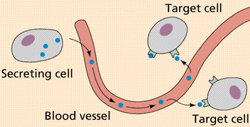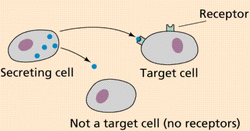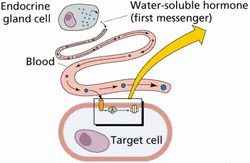Basic Information
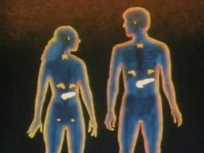
The endocrine system consists of endocrine glands and exocrine glands. Endocrine glands release hormones, chemical substances that deliver messages to the body, directly into the bloodstream. The hormones will only lock onto and affect the receptors of thierintended cells. Exocrine glands have ducts they release their products through. For example, sweat glands produce sweat that flows out of the skin through tubelike sweat ducts. All glands besides the pancreas are either exocrine or endocrine.
Breaking it down: Level 1: Functions
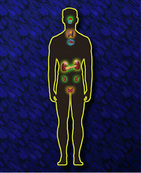
Hormones coordinate organ system activity. All of the glands work to maintain internal homeostasis.The six major glands that control most activites are the pancreas, thyroid, parathyroid, adrenals, gonads and pituitary. Growth and water balance are controlled by the pituitary. Reproduction is controlled by the pituitary as well as the ovaries (in females) and testes (in males). Metabolism is controlled by the thyroid. Calcium and glucose levels are controlled by the thyroid, parathyroid annd pancreas. Stress, and the fight or flight response, is controlled by the adrenal glands (this is why epinephrin is commonly called adrenaline). The endocrine system is also to thank for everyone's favorite stage of life: PUBERTY!
Breaking it down: Level 2: Some Important Glands
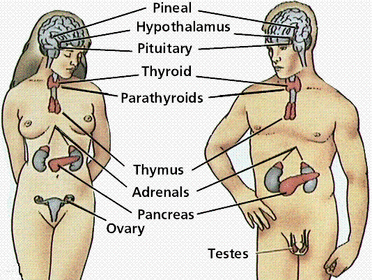
Centuries ago, it was believed that the pineal gland, the gland that lies between the two cerebral hemispheres above the spinal column, controlled the flow of memories into consciousness. Now, it is known that the pineal gland secretes melatonin. Melatonin helps regulate the body's circadian rhythm.
The hypothalamus is a gland found in the brain that secretes hormones that regulate thirst, hunger, body temperature, sleep, moods, libido and the release of hormones from various glands. It bridges the barrier betweent he endocrine system and the nervous system.
The pituitary gland, sometimes called the master gland, is found deep in the middle of the brain below the hypothalamus. The pituitary cotrols tissue growth and makes growth hormone, TSH (thyroid stimulating hormone), follicle stimulating hormone (FSH), prolactin (in nursing females), and ADH (antidiuretic hormone) just to name a few.
The thyroid gland is found in the front of the neck. The thyroid takes the iodine found in many foods and converts it into the thyroid hormones thyroxine and triiodothyronine. The thyroid controls the rate a body uses energy and makes proteins. It also controls how sensitive the body is to other hormones. The thyroid is under the control of the pituitary gland which is regulted by the hypothalamus.
The four parathyroid glands are located on the back and sides of the thyroid. They secrete parathyroid hormone which regulates blood calcium.
The thymus is supposedly named such because it resembles the seasoning thyme. It is found in the upper chest behind the sternum. It grows during childhood but decreases in size once a human has reached maturirty. It is in the thymus that T-cells are created ("T" stands for thymus) which play a large role int he body's immunoligical system. Thymus hormones are called thymosins which stimulate the development and diferentiation of T cells.
The adrenal glands sit on top of the kidneys. They are triangular in shape. Each glands consists of a medulla, or center, surrounded by a cortex, or covering. The medulla is responsible for producing epinephrin and nonepinephrine. The adrenal are mainly responsible for secreting hormes that deal with stress. However, they also produce hormes that aids in fluid and electroll
The pancreas is found in the digestive system and secretes digestive enzymes and makes insulin and glucagon which regulate blood sugar.
The two ovary glands are found in the pelvis of females. They produce gametes (eggs) and release the female sex hormones estrogen and progesterone.
The two testes are located in the scrotum of males. They produce gametes (sperm) and the male sex hormones (the most well known of these being testosterone).
The hypothalamus is a gland found in the brain that secretes hormones that regulate thirst, hunger, body temperature, sleep, moods, libido and the release of hormones from various glands. It bridges the barrier betweent he endocrine system and the nervous system.
The pituitary gland, sometimes called the master gland, is found deep in the middle of the brain below the hypothalamus. The pituitary cotrols tissue growth and makes growth hormone, TSH (thyroid stimulating hormone), follicle stimulating hormone (FSH), prolactin (in nursing females), and ADH (antidiuretic hormone) just to name a few.
The thyroid gland is found in the front of the neck. The thyroid takes the iodine found in many foods and converts it into the thyroid hormones thyroxine and triiodothyronine. The thyroid controls the rate a body uses energy and makes proteins. It also controls how sensitive the body is to other hormones. The thyroid is under the control of the pituitary gland which is regulted by the hypothalamus.
The four parathyroid glands are located on the back and sides of the thyroid. They secrete parathyroid hormone which regulates blood calcium.
The thymus is supposedly named such because it resembles the seasoning thyme. It is found in the upper chest behind the sternum. It grows during childhood but decreases in size once a human has reached maturirty. It is in the thymus that T-cells are created ("T" stands for thymus) which play a large role int he body's immunoligical system. Thymus hormones are called thymosins which stimulate the development and diferentiation of T cells.
The adrenal glands sit on top of the kidneys. They are triangular in shape. Each glands consists of a medulla, or center, surrounded by a cortex, or covering. The medulla is responsible for producing epinephrin and nonepinephrine. The adrenal are mainly responsible for secreting hormes that deal with stress. However, they also produce hormes that aids in fluid and electroll
The pancreas is found in the digestive system and secretes digestive enzymes and makes insulin and glucagon which regulate blood sugar.
The two ovary glands are found in the pelvis of females. They produce gametes (eggs) and release the female sex hormones estrogen and progesterone.
The two testes are located in the scrotum of males. They produce gametes (sperm) and the male sex hormones (the most well known of these being testosterone).
Breaking it down: Level 3: Some Important Hormones
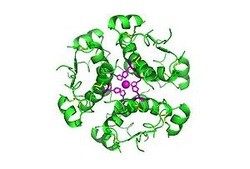
In our lives we hear a lot about the hormone insulin because it is the hormone associated with the rampant disease diabetes. Insulin is a protein secreted by the pancreas in a response to an increase in blood sugar and most cells have insulin receptors. When a cell has insulin attached to its surface the cell can abosorb glucose from the blood stream and into itself. Without insulin cells can use the calroies in glucose very well and the organism would go into a state of starvation no matter how much food it was eating. Pictured to the right is a insulin hexamer.
Glucagon is the other hormone secreted by the pancreas. Glucagon raises the amount of blood sugar circulating in the blood so more glucose can be delivered to cells (it does the opposite job of insulin). An injection of glucagon can help quickly raise blood sugar if someone is hypoglycemic.
Thyroxine is a hormone made by the thyroid gland. It stimulates the consumption of oxygen and thus the metabloism of all cells and tissues in the body. Excessive secretion of thyroxine leads to hyperthyroidism and deficit of it leads to hypothyroidism.
Epinephrine, commonly known as adrenaline, is both a hormone and neurotransmitter made by the adrenal glands. When it is released in response to stress, the heart rate elevates, blood vessels contract, air passages and pupils dialate and an elevated sense of consciousness is felt.
Also, most hormones are peptides: short chains of amino acids.
Side Note A: How do hormones work?
Side Note B: Steroid and Non-Steroid Hormones
Steroid Hormones
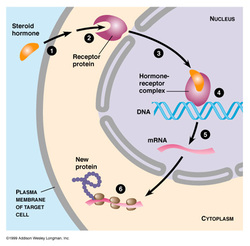
Steroids are lipids derived from chlosterols. They directly affect gene expression in the targeted cell. They are lipid soluble and can diffuse directly through the membrane of a cell to the receptor sites in the nucleus. Once inside, the activated horomone receptor activates specefic genes increasing the production of related proteins.
Steroid hormones include progesterone, testosterone, cortisol and estrogen.
They are grouped into five groups according to which receptors they bind to: glucocorticoids, mineralcorticoids, androgens, estrogens, and progestagens.
Steroid hormones include progesterone, testosterone, cortisol and estrogen.
They are grouped into five groups according to which receptors they bind to: glucocorticoids, mineralcorticoids, androgens, estrogens, and progestagens.
Second Helping: The One and Only Pancreas: Both Endocrine and Exocrine
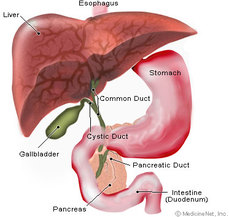
Found in the abdominal cavitity, the pancreas makes insulin and glucagon which help the body maintain its blood sugar levels. The islets of Langerhans is the name for the group of cells that secrete these hormones.
This is the pancreas's endocrine job. The pancreas also functions as an exocrine gland that aids in digestion. Nonendoncrine cells in the pancreas produce digestive enzymes that go to the duodenum (small intestines) via ducts. These enzymes break down proteins and carbohydrates so they can be digested.
Pancreatic cancer, malignant neoplasm of the pancreas, is one of the most deadly forms of cancer with a prognonis of a 5% survival rate five years after diagnosis.
This is the pancreas's endocrine job. The pancreas also functions as an exocrine gland that aids in digestion. Nonendoncrine cells in the pancreas produce digestive enzymes that go to the duodenum (small intestines) via ducts. These enzymes break down proteins and carbohydrates so they can be digested.
Pancreatic cancer, malignant neoplasm of the pancreas, is one of the most deadly forms of cancer with a prognonis of a 5% survival rate five years after diagnosis.
Image Citations:
http://movingspaceproductions.com/index.php?key=signaling&page=6
http://thebodytemplebook.com/store/index.php?main_page=product_info&cPath=1&products_id=18
http://www.emc.maricopa.edu/faculty/farabee/biobk/biobookendocr.html
http://en.wikipedia.org/wiki/Insulin
http://fitnesslines.com/health-tips/diabetesimpact-of-diabetes-causes-diahttp://schoolworkhelper.net/2010/07/the-endocrine-system-function-and-structure/betes-diabetes-symptoms-how-is-diabetes-diagnosed/
http://schoolworkhelper.net/2010/07/the-endocrine-system-function-and-structure/
http://thebodytemplebook.com/store/index.php?main_page=product_info&cPath=1&products_id=18
http://www.emc.maricopa.edu/faculty/farabee/biobk/biobookendocr.html
http://en.wikipedia.org/wiki/Insulin
http://fitnesslines.com/health-tips/diabetesimpact-of-diabetes-causes-diahttp://schoolworkhelper.net/2010/07/the-endocrine-system-function-and-structure/betes-diabetes-symptoms-how-is-diabetes-diagnosed/
http://schoolworkhelper.net/2010/07/the-endocrine-system-function-and-structure/
